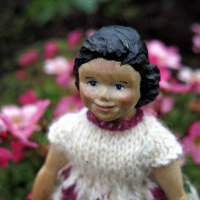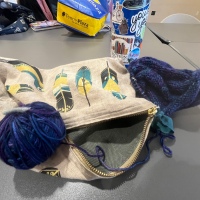Lessons from Skilled Work
Just in time for National Craft Month, I read an essay with the lovely title, “Metaphysical Implications of Function, Material, and Technique in Craft,” by Howard Risatti*. It’s in a 1998 exhibition catalog, Skilled Work: American Craft in the Renwick Gallery, from the Smithsonian’s National Museum of American Art. It’s a long essay, 22 pages, so I can just skim the surface here, but it has helped me structure my thoughts on art and craft and their place in my life.
Real Life
First, Risatti points out that craft offers real experience, in contrast to “the contrived needs and pseudo-events that bombard us on TV and in the movies.”
In the postmodern world, so the argument goes, the natural hardly exists, and reality itself is always mediated in some way….Whatever remains of the “real” world is generally experienced secondhand, predigested via the media, TV, and the movies so that “real” life experience tends to be overwhelmed by lifestyle images….
Craft offers an important way to negotiate this predicament and return to experiences that are real – real because necessary, direct, and genuinely meaningful. (p. 34)
Origins of Craft
Risatti explains that craft objects originated from naturally occurring objects that humans found useful. He sorts these objects into three basic categories – containers, shelters, and supports (such as seats and tables). In other words, thousands of years ago when we saw a lake as a container for water, and realized we could create a more convenient version, we made sure that it met our other needs, by being an easy size to carry, an easy shape to set down, with a surface that was comfortable to touch, and so on.
Because craft is based on natural materials, it is constrained by the laws of physics, by what each particular material can do.
…materials are treated in ways that coax out the intrinsic properties of the material. In a sense, this is a dialogue with nature conducted through technique and material. (p. 43)
Risatti tends to emphasize the impact of the artisan, but that phrase, “a dialogue with nature”, made me think more about nature’s strong contribution to new ideas. I know when I notice something in nature like an interesting vine, I think, “you know what would be good to do with that…”
Because each craft object has to be functional, it ends up following a basic pattern that is common across eras and cultures. So a seat is a seat is a seat, and we can recognize its basic function whether it’s from King Tut’s tomb or a log cabin.
But craft is also called the “applied arts.” It is human nature to express oneself somehow, within those constraints. Techniques and traditions have built up within each craft, helping artisans bring out the intrinsic qualities of their materials. These skills can build bridges across cultures.
Craft in Contrast with Fine Art and Mass-Production
Risatti then contrasts the functional nature of craft with the more intangible nature of the fine arts.
While physical needs do not change over the lifetime of an individual or over the course of centuries, psychic needs do change in reaction to altered social, political, and economic situations, These changes are reflected in the fine arts. (p. 35)
..the practitioners of the fine arts work to overcome the limitations of their materials, whereas those engaged in the applied arts work in concert with their materials. (p. 38, emphasis his)
The fine artist is an ‘image’ maker, whereas the applied artist is an ‘object’ maker. (p. 40)
He also contrasts craft with modern mass-produced objects, which are created based on cheapness and machine efficiency, regardless of true functionality for humans. Risatti gives the example of packing boxes, which are cheap to manufacture, ship, and store, but which are awkward for humans to grasp and hold. People have come to view an individually made craft object as:
…a quaint historical curiosity, an anachronism, while ‘real’ functional objects are engineered by designers…the value of all objects tends to be based on their perceived efficiency. (p.47)
And So Where Does This Leave Us?
This essay really helped me figure out where I am in the whole art/craft continuum, and the area I would like to focus on.
You may take issue with the way that Risatti defines and separates “art” from “craft”, (although I am greatly summarizing the essay, and he does go into it in much more depth) and I think for a lot of people, the two blend seamlessly. But after reading this I would put myself more on the craft side – I prefer handmade objects to mass-produced, and I enjoy spending some time and effort to make them. I do feel that they give meaningful experiences to my life. But I guess that modern value on efficiency has affected me too, because I like to make simple things with a useful purpose – I admire masterpieces, but I don’t have a desire to make them myself.
The aspect of craft that I value most is the way it provides a bridge to people in different times, cultures, and circumstances. I can speak the same language as other craftspeople, and be inspired by their individual traits of expression.

I know how the weaver did this! I couldn’t do it so skillfully, but I could figure out the steps involved.
When I look at a medieval weaving illustration and think, “I know what she is doing!” I can feel that connection across the centuries. When I read stories of sharing textile joy across cultures and language barriers, like this account by Verónica, I wish I could have been there too.
I am sure that any hobby or interest can be shared this way, but figuring out that this is my favorite aspect of craft – this bridge of sharing ideas and skills – helps me decide where to focus my time and effort. I don’t have to have the best of all possible materials or equipment, because I am most interested in just sampling different techniques. I will always be willing to give an informal weaving or dyeing lesson, because passing on the skill is the part I like best!
I don’t often see essays on the value of art and craft – I got so many ideas from this one! If you have any other good books or articles on a philosophy of art to suggest, please let me know.
* I just looked him up and he is professor emeritus of art, craft, and critical theory at Virginia Commonwealth University.



















Thoughtful and refreshing, Ranger. Thanks for getting my day off to a centered start. John
I worked on this post on and off for about a week, and during that time I read your mindfulness post, and to me the two subjects fit together – by being mindful of my craft pastime, I can follow it more meaningfully. It’s always like that for me though – every post I read seems to have a serendipitous connection with what I’ve been thinking about – I guess I just find good blogs to follow! 🙂
Excellent post!!! This definitely ‘tags’ into the controversy surrounding the “value”/pricing of quilts by their makers. After reading the above, I believe a quilt would bridge the two arts……fine and applied. The finished quilt, which may be hung for display, providing added beauty/atmosphere to the surroundings would certainly qualify as “fine” but would equally fall into the “applied” category with its usefulness as a bedcovering, providing warmth. Much of the “craft vs. art” tension comes about when personal opinion and a low dollar value comes into play. I don’t see an easy resolution, but (for my part) one of the reasons I blog is to educate others to the quilting process and, hopefully in doing so, provide information to change/modify viewpoints that would relegate this artform to merely something that “fills spare time” and supports a rapidly exploding textile industry. From this comment, you are aware that your post has triggered much thought for me and I thank you!!!! I do hope you enjoy future visits to my “place”……………hugs………………….
He gave a good history of how the “art” versus “craft” valuation came into play after WWII, and how craftspeople have wrestled with that. I think I liked the essay so much because it gave me a structure to think about that issue – I once read a comment by a quilter that if people would stop giving away so many quilts, she could get a higher price for her work. I think now I would be able to say, “My crafty little charity quilt is not competing with your fine art quilt. You should get a good price, but I am not willing to deny someone who needs it, a humble handmade object. I think they are in two different worlds.” I think art quilting is a wonderful fine art form, but for me it was good to recognize that I am more comfortable on the basic side.
And you should know I just ordered Quilting Wide Open Spaces after reading your post! I can tell that it is going to give me lots of ideas.
I am so glad you found the review of value and hope you do enjoy all that Judi put into her book.
Your post “dove-tailed” a conversation DH and I had over breakfast this very morning. I experienced such pricing discrepancies/challenges when I had my sewing business (bridal/formal wear). While renting space in our little town (Houston,MN) it was less of an issue (although, there were those who thought may already low prices were too high cuz of my small-town location!!!!!) but when I moved my business to our home (to better accommodate flexible hours for my clientele) it was definitely expressed. “Custom” doesn’t carry the weight/value that it should nor did it ever truly resonate that a discount gown price PLUS alterations will cost the same as a custom garment made to fit…..one resulting in an “off the rack” dress and the other a garment that fits “you”. Ppl are so dense/ingrained!!!!!!
I’m so glad you stopped by for a visit and hope to “see” you again!!!!!! Hugs……..Doreen
We are kindred spirits, for sure. I spend a great deal of time thinking about the issues you wrote about and trying to figure out my place in the mix. Like you, I love the making and the connecting–I read a lot about crafting and textiles across time and culture and feel a little thrill that I’m engaged in an activity that women, so like myself and yet so different, have been endeavoring in for centuries. Question–is the Risatti article available online?
I am happy to be a kindred spirit with you!
I didn’t find that exact essay online, but he has written for about ten craft magazines, and I see that he wrote a 352 page book on the subject – with illustrations! available for Kindle! It seems I will be reading more on the subject…
Excellent–thanks for the lead!
You almost lost me when I read the title of his article but I decided to go on and read it anyway. I’m glad I did. That and the comments posted after it were very interesting and gave me a new perspective .
Yes, but now you can go around and brag to all your friends that you read things about metaphysical implications! Don’t you feel smarter already? 🙂
Seriously, I’m glad you liked it. I love to read things that make me see a fresh perspective!
Thanks for this — lots to think about. One other aspect that doesn’t seem to be touched here is creation/creativity. What is the difference between the designer or creator of an object (or a piece of writing or music or …) and one who executes the design? If you run a studio of potters, for example, and you design the vases, but other potters make them, they are crafters, yes? But what are you? If you compose a piece of music and others play it as written, no doubt they are talented. But who is the artist, the creator of that piece of art? Is a designer of craft an artist? Is the designer of non-craft an artist?
I don’t have answers but I think the questions are worth considering.
Thanks again.
You’re right – that aspect was not touched on in the essay, even in the parts I didn’t cover. The exhibition and catalog were put together for the 25th anniversary of the Renwick Gallery, and Risatti did give a little history – “Its purpose is to promote contemporary American craft and establish its credibility as a genuine form of artist expression,one just as worthy as the paintings and sculptures in other Smithsonian collections. To do this was no small matter, for it was a momentous time…major change in society…end of the idea of modern art…beginning of what has become known as the postmodern world, dominated by electronic media and technology.” So I think his aim was to be an apologist for “craft” standing equally with “art,” just maybe coming from a different direction.
Now you have me so curious about the works shown in the catalog – which were made by the individual they are attributed to? Were any of them made in studios with teams of people as you were mentioning? It seems like some must have been!
I am also curious why paper, leather, and plastic weren’t included at all.
Every idea brings forth some equal and opposite questions!
And this is where (very) small group study would be especially fun.
I enjoy your blog and the range of information you bring. Thanks.
Melanie, I just looked at information about a book he wrote on this topic in 2007 – there is a whole chapter on the designer/craftsman question!
And? is it library-available?
I don’t even know how to find that out! I am so used to the books I am interested in, being so far off the beaten path that regular libraries don’t have them, that I just look to buy the books. Now that you asked, I am remembering that there is some World Cat site or something, but I don’t know how to find out. Here’s the title – A Theory of Craft: Function and Aesthetic Expression. Can you tell me where I would find out about the library availability?
… Well, I don’t know. That’s something I’ve wondered about, too. I did realize a couple of years ago that I was ignoring our university library when I looked stuff up. I don’t know how far you are from the rest of the world, but if you have universities nearby, you should check their online catalogs, too. The academic works you like may be more readily available there.
Beautiful essay!! I will be writing about the artisan movement soon so will definitely be referencing this. Thanks you! 🙂
I’m glad you liked it and hope it will be useful to you and your excellent blog!
xo 🙂
Great and Informative Post. Thank you for sharing. Blessings, Mtetar
Glad you liked it – you are so detail-oriented in thinking of creative projects to do with your granddaughter – if there was a Smithsonian Gallery for Crafty Caretakers, you would be in it! 🙂
Oh Wow thank you so much for such uplifting words. Your posts are worth sharing. Blessings Always, Mtetar
Pingback: The Difference Between Art and Craft | The Snarky Quilter